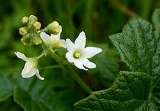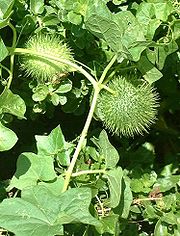
California Manroot
Encyclopedia
Marah fabaceus, the California Manroot or Bigroot, is the most common of the manroot
species native to California
. Its range throughout the state subsumes nearly the entire ranges of all the other California native manroots species and intergrades. Hybrids between California manroot and the other species are common.
s. Vines appear in late winter in response to increased rainfall, and can climb or scramble to a length of 6 meters. Its leaves typically have five lobes with individual plants showing wide variation in leaf size and lobe length.
Vines emerge from a large, hard tuberous root
which can reach several meters in length and weigh in excess of 100 kilograms. Newly exposed tubers can be seen along roadcuts or eroded slopes and have a scaley, tan-colored surface. Injured or decaying tubers take on a golden or orange color.
, that is, individual flowers are either male or female, but both sexes can be found on the same plant. Male flowers appear in open clusters while females flowers, distinguished by a swollen base, usually appear individually. The plant is self-fertile; pollen from the male flowers can fertilise the female flowers on the same plant. Pollination
is by insect
s.

, at elevations up to 1600 metres. It ranges through most of California except the far northwest and the Mojave Desert
. It will tolerate a variety of soil types and acidities, but it requires seasonally moist soil. Vines can grow in full-sun to partially shaded conditions. In mild areas where year-round moisture is available, vines can be perennial
. In the Mediterranean climate
areas of California, manroot emerges soon after winter rains begin, grows until late spring, and dies back completely in the heat and dryness of summer.
and Contra Costa County
), and Marah fabaceus var. fabaceus (found elsewhere in California). An example occurrence of M.f. agrestis is on Ring Mountain in Marin County, California
.
The tubers of Marah fabaceus were crushed and thrown into surface waters by the Kumeyaay
to immobilize fish. The tuber
s contain megharrhin, a saponin
-like glucoside
. Saponins lower the surface tension
of water allowing the formation of bubbles. It is likely that the substance enters the fish's circulation through the gill arches where only a single-cell epithelium
separates the water from the animal’s red blood cells. The affected fish float to the surface.
All parts of the plant have a bitter taste (this is the meaning of the genus name Marah, which comes from Hebrew). Despite this, the leaves have been used as a vegetable. Due to its saponin content, the large tuber of the manroot can be processed for a soap-like extract.
Manroot
The manroots, wild cucumbers, or cucumber gourd are flowering plants in the gourd family , native to western North America. They are also commonly called Old man in the ground. The genus name comes from Hebrew מָרָ֔א The manroots, wild cucumbers, or cucumber gourd (genus Marah) are flowering...
species native to California
California
California is a state located on the West Coast of the United States. It is by far the most populous U.S. state, and the third-largest by land area...
. Its range throughout the state subsumes nearly the entire ranges of all the other California native manroots species and intergrades. Hybrids between California manroot and the other species are common.
Foliage
Like other manroots, Marah fabaceus has stout, hairy stems with tendrilTendril
In botany, a tendril is a specialized stem, leaf or petiole with a threadlike shape that is used by climbing plants for support, attachment and cellular invasion by parasitic plants, generally by twining around suitable hosts. They do not have a lamina or blade, but they can photosynthesize...
s. Vines appear in late winter in response to increased rainfall, and can climb or scramble to a length of 6 meters. Its leaves typically have five lobes with individual plants showing wide variation in leaf size and lobe length.
Vines emerge from a large, hard tuberous root
Tuber
Tubers are various types of modified plant structures that are enlarged to store nutrients. They are used by plants to survive the winter or dry months and provide energy and nutrients for regrowth during the next growing season and they are a means of asexual reproduction...
which can reach several meters in length and weigh in excess of 100 kilograms. Newly exposed tubers can be seen along roadcuts or eroded slopes and have a scaley, tan-colored surface. Injured or decaying tubers take on a golden or orange color.
Flower
The flower can vary in colour from yellowish green to cream to white. Flowers appear soon after the vine emerges. The flowers are monoeciousPlant sexuality
Plant sexuality covers the wide variety of sexual reproduction systems found across the plant kingdom. This article describes morphological aspects of sexual reproduction of plants....
, that is, individual flowers are either male or female, but both sexes can be found on the same plant. Male flowers appear in open clusters while females flowers, distinguished by a swollen base, usually appear individually. The plant is self-fertile; pollen from the male flowers can fertilise the female flowers on the same plant. Pollination
Pollination
Pollination is the process by which pollen is transferred in plants, thereby enabling fertilisation and sexual reproduction. Pollen grains transport the male gametes to where the female gamete are contained within the carpel; in gymnosperms the pollen is directly applied to the ovule itself...
is by insect
Insect
Insects are a class of living creatures within the arthropods that have a chitinous exoskeleton, a three-part body , three pairs of jointed legs, compound eyes, and two antennae...
s.

Fruit
The fruit is spherical, 4 to 5 centimeters in diameter, and covered in prickles of variable density, up to 1 centimeter long but without hooks. Unripe fruit are bright green, ripening to yellow. The fruit swells as it ripens until finally rupturing and releasing the large seeds. Fruit begin to form in spring and ripen by early summer.Seeds & Germination
Seeds of the California manroot are large, hard, and very smooth. Fruit usually hold 4 or more seeds. Seeds sprout in the cool wetness of late winter. Seeds have an intriguing germination process. The initial shoot emerges from the seed and grows downward into the earth. This shoot then splits, one part beginning to swell and form the tuber, while the second part grows back to the surface and becomes the vine.Ecology
The California manroot grows most vigorously by streams or in washes but is also successful in dry chaparralChaparral
Chaparral is a shrubland or heathland plant community found primarily in the U.S. state of California and in the northern portion of the Baja California peninsula, Mexico...
, at elevations up to 1600 metres. It ranges through most of California except the far northwest and the Mojave Desert
Mojave Desert
The Mojave Desert occupies a significant portion of southeastern California and smaller parts of central California, southern Nevada, southwestern Utah and northwestern Arizona, in the United States...
. It will tolerate a variety of soil types and acidities, but it requires seasonally moist soil. Vines can grow in full-sun to partially shaded conditions. In mild areas where year-round moisture is available, vines can be perennial
Perennial plant
A perennial plant or simply perennial is a plant that lives for more than two years. The term is often used to differentiate a plant from shorter lived annuals and biennials. The term is sometimes misused by commercial gardeners or horticulturalists to describe only herbaceous perennials...
. In the Mediterranean climate
Mediterranean climate
A Mediterranean climate is the climate typical of most of the lands in the Mediterranean Basin, and is a particular variety of subtropical climate...
areas of California, manroot emerges soon after winter rains begin, grows until late spring, and dies back completely in the heat and dryness of summer.
General
Two varieties are recognised, Marah fabaceus var. agrestis (found in the San Francisco Bay AreaSan Francisco Bay Area
The San Francisco Bay Area, commonly known as the Bay Area, is a populated region that surrounds the San Francisco and San Pablo estuaries in Northern California. The region encompasses metropolitan areas of San Francisco, Oakland, and San Jose, along with smaller urban and rural areas...
and Contra Costa County
Contra Costa County, California
Contra Costa County is a primarily suburban county in the San Francisco Bay Area of the U.S. state of California. As of the 2010 census, it had a population of 1,049,025...
), and Marah fabaceus var. fabaceus (found elsewhere in California). An example occurrence of M.f. agrestis is on Ring Mountain in Marin County, California
Marin County, California
Marin County is a county located in the North San Francisco Bay Area of the U.S. state of California, across the Golden Gate Bridge from San Francisco. As of 2010, the population was 252,409. The county seat is San Rafael and the largest employer is the county government. Marin County is well...
.
The tubers of Marah fabaceus were crushed and thrown into surface waters by the Kumeyaay
Kumeyaay
The Kumeyaay, also known as Tipai-Ipai, Kamia, or formerly Diegueño, are Native American people of the extreme southwestern United States and northwest Mexico. They live in the states of California in the US and Baja California in Mexico. In Spanish, the name is commonly spelled...
to immobilize fish. The tuber
Tuber
Tubers are various types of modified plant structures that are enlarged to store nutrients. They are used by plants to survive the winter or dry months and provide energy and nutrients for regrowth during the next growing season and they are a means of asexual reproduction...
s contain megharrhin, a saponin
Saponin
Saponins are a class of chemical compounds, one of many secondary metabolites found in natural sources, with saponins found in particular abundance in various plant species...
-like glucoside
Glucoside
A glucoside is a glycoside that is derived from glucose. Glucosides are common in plants, but rare in animals. Glucose is produced when a glucoside is hydrolysed by purely chemical means, or decomposed by fermentation or enzymes....
. Saponins lower the surface tension
Surface tension
Surface tension is a property of the surface of a liquid that allows it to resist an external force. It is revealed, for example, in floating of some objects on the surface of water, even though they are denser than water, and in the ability of some insects to run on the water surface...
of water allowing the formation of bubbles. It is likely that the substance enters the fish's circulation through the gill arches where only a single-cell epithelium
Epithelium
Epithelium is one of the four basic types of animal tissue, along with connective tissue, muscle tissue and nervous tissue. Epithelial tissues line the cavities and surfaces of structures throughout the body, and also form many glands. Functions of epithelial cells include secretion, selective...
separates the water from the animal’s red blood cells. The affected fish float to the surface.
All parts of the plant have a bitter taste (this is the meaning of the genus name Marah, which comes from Hebrew). Despite this, the leaves have been used as a vegetable. Due to its saponin content, the large tuber of the manroot can be processed for a soap-like extract.

